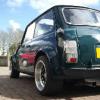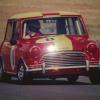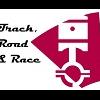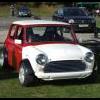
Rear Tracking Help
#1

Posted 15 October 2012 - 09:49 PM
also have the front set up as following
toe-out 6mm = 1 deg
camber 1.5
caster 3deg
rear is showing
L/H toe-out 6mm
R/H toe-in 2mm
i believe from what i was told but the rear was tracked using the front wheels which like i said before seems to be the wrong way to do it so i want to go back prepared this time on knowing what to set it as and how to do it properly.
ideally end rear settings to be if not correct please help
0.5 deg camber and 2mm toe-in
thanks for any help will be much appreciated
#2

Posted 16 October 2012 - 05:00 PM
#3

Posted 16 October 2012 - 05:07 PM
why have you gor 6mm toe out on the front, front rest ok
2 mm toe in and half deg camber fine rear
i think you need to take it to a more specialist
#4

Posted 16 October 2012 - 05:24 PM
#5

Posted 16 October 2012 - 05:39 PM
The big problem with Mini tracking is the inaccuracies and tolerances in both subframes and the actual bodyshell, especially if it has been restored and welded a lot.
#6

Posted 16 October 2012 - 05:46 PM
#7

Posted 16 October 2012 - 05:54 PM
#8

Posted 16 October 2012 - 06:30 PM
#9

Posted 16 October 2012 - 08:27 PM
You need to discuss this with the company who have the tracking kit. The front must toe-out about 1 mm to 2 mm and the rear toe in 2 mm to 3 mm and the relative alignment of frone & rear wheels must be symetrical both sides relative to the centre-line of the car. The problem comes when the front & rear sub-frames are not themselves in line with each other. If I were to tell you how I do it I'll be 'shot down' for not doing it accurately, despite the fact that it works!
Yeah likewise, the method I use works really well and has sorted numerous 'odd handling' issues out... like cooperman says though: " If I were to tell you how I do it I'll be 'shot down' for not doing it accurately, despite the fact that it works!"
Edited by icklemini, 16 October 2012 - 08:27 PM.
#10

Posted 16 October 2012 - 09:11 PM
#11

Posted 16 October 2012 - 09:16 PM
#12

Posted 16 October 2012 - 09:22 PM
And obviously 4 wheel laser is going to beat string/wood -but we don't all have access to that kind of gear -while a ball of string is usually affordable !
Edited by bmcecosse, 16 October 2012 - 09:24 PM.
#13

Posted 16 October 2012 - 09:33 PM
#14

Posted 16 October 2012 - 09:55 PM
The key to getting it correct is first of all to remove any out-of-geometry 'crabbing'. At this stage forget about toe-in and toe-out on the rear. Set the toe-in on the front to between 1 mm and 2 mm. Now we'll revert to the measurting system used on the original Mini design - feet and inches.
So if the front is set to the correct toe-in and then the car is driven forward in an exact straight line the wheels will be parallel to the line of travel.
As the rear track is 2" narrower than the front a straight line drawn backwards from the outside edges of the front wheel rims should be the same distance from the wheel rims on the same sides. In fact it should be 1" minus 7ft, which is the nominal distance between wheel centres x set toe-in (assuming a 12" wheel diameter). If we call it 1.5 mm toe in, the average distance to the wheel edges at the rear will be 7 x 1/16" (i.e. 1.5 mm) = 1 - 7/16 = 9/16".
However, it's not quite that simple (of course) as errors in rear toe will adversly affect this measurement.
But, we can work from back to front using two long straight edges from back to front and seeing where they touch the tyre tread. With the front wheels straight ahead the straight edge from rear to front when just touching the sides of the tyre should be 1" plus 1/2 the existing rear toe-in in from the edge of a straight edge placed across the edge of the front tyre on both sides multiplied by 6ft (the approximate distance from rear wheel centre to outer tyre diameter). So roughly 1.375". All these measurements are taken across the horizontal centre line of the wheels using axle stands, milk crates or whatever to get the heights correct.
If the car is not parallel from these measurements, and reference to the sides of the car can help when doing this and the rear wheels found to be be out of line with the front side to side the rear radius arm brackets need to be either shimmed back or the centre hole filed forward to get the necessary parallelism.
Once the rears are the same each side with respect to the front, the rear track can be set to the required figure by adjusting each side equally.
Without the setting tools, this does work and is usually adequate for a road car, although for competition a more accurate setting is normally desirable.
I hope this has given the raw basics. A diagram is obviously better and I'll try to find time to do one and scan it in, but I might have to send it to those who need it and who PM me their email addresses.
Now, before I get shot down for being inaccurate, I'm only posting this to give an idea of what is involved if you don't have 4-wheel tracking equipment, which I know is the real answer.
To hold the position of the radius arm pin in a filed bracket hole a large washer should be welded on once the accurate position is set.
1 user(s) are reading this topic
0 members, 1 guests, 0 anonymous users


















